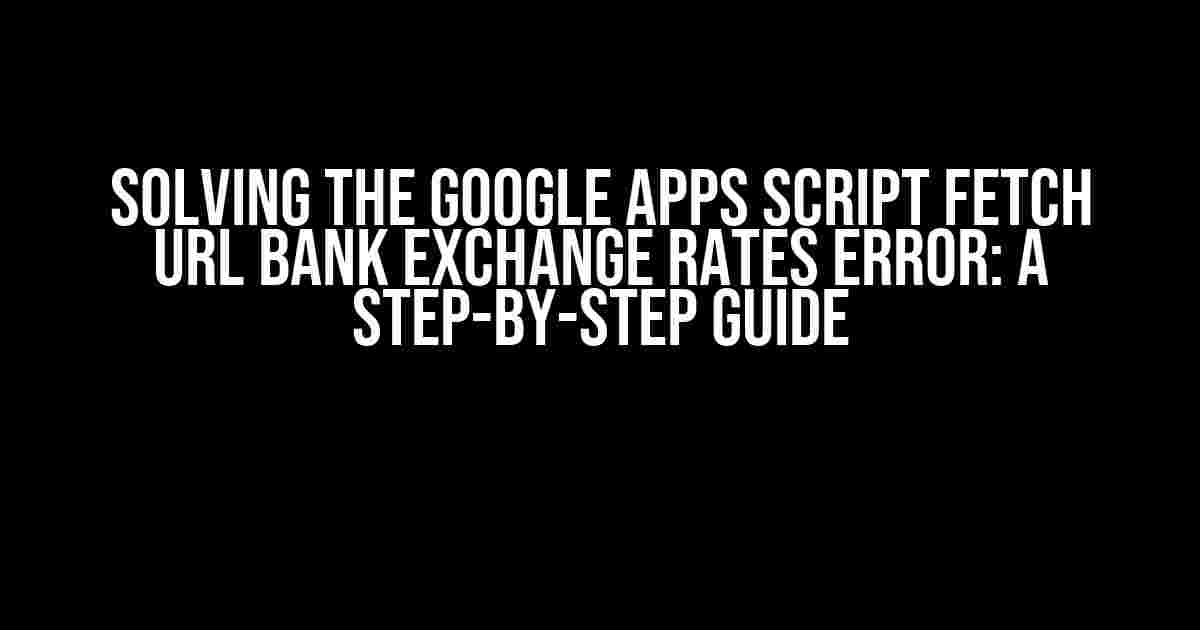Are you struggling with the Google Apps Script fetch URL bank exchange rates error? You’re not alone! Many developers have faced this frustrating issue, but don’t worry, we’ve got you covered. In this comprehensive guide, we’ll take you through a step-by-step process to resolve this error and get your exchange rates fetched successfully.
What Causes the Error?
Before we dive into the solution, let’s understand what causes this error. The Google Apps Script fetch URL bank exchange rates error typically occurs when the script is unable to retrieve exchange rates from an external API. This can be due to various reasons, including:
- API rate limits exceeding
- Incorrect API endpoint or parameters
- Network connectivity issues
- Script permissions or authentication problems
Step 1: Choose the Right API
The first step in resolving the error is to choose a reliable API that provides accurate and up-to-date exchange rates. We recommend using the European Central Bank’s (ECB) exchange rates API, which is free and easy to use. You can find the API documentation here.
ECB API Endpoint
The ECB API endpoint is https://exchangeratesapi.io/latest. You can fetch the latest exchange rates by sending a GET request to this endpoint.
var apiUrl = "https://exchangeratesapi.io/latest";
var response = UrlFetchApp.fetch(apiUrl);
var json = JSON.parse(response.getContentText());
Step 2: Set Up API Permissions
To fetch exchange rates, your Google Apps Script needs to have the necessary permissions. Follow these steps to set up API permissions:
- Open your Google Apps Script project
- Click on “Resources” in the menu
- Select “Advanced Google services” from the drop-down menu
- Enable the “UrlFetchApp” service
UrlFetchApp Permissions
Make sure you have the necessary permissions to use the UrlFetchApp service. You can check the permissions by going to “File” > “Project properties” > “Scopes”. Look for the https://www.googleapis.com/auth/script.external_request scope and make sure it’s enabled.
Step 3: Handle API Rate Limits
Most APIs have rate limits to prevent abuse. To avoid hitting these limits, you can implement a caching mechanism to store fetched exchange rates. This way, you can reduce the number of API requests and avoid errors.
caching Mechanism
Create a cache service to store fetched exchange rates. You can use the CacheService provided by Google Apps Script.
var cache = CacheService.getScriptCache();
var cacheDuration = 3600; // 1 hour
var cachedRates = cache.get("exchangeRates");
Step 4: Fetch Exchange Rates
Now that you’ve set up the API permissions and caching mechanism, it’s time to fetch exchange rates. Use the following code to fetch the latest exchange rates:
function fetchExchangeRates() {
var apiUrl = "https://exchangeratesapi.io/latest";
var response = UrlFetchApp.fetch(apiUrl);
var json = JSON.parse(response.getContentText());
var rates = json.rates;
// Cache the fetched rates
cache.put("exchangeRates", rates, cacheDuration);
return rates;
}
Step 5: Handle Errors
Even with the caching mechanism, errors can still occur. To handle errors, you can use a try-catch block to catch and log any exceptions.
function fetchExchangeRates() {
try {
var apiUrl = "https://exchangeratesapi.io/latest";
var response = UrlFetchApp.fetch(apiUrl);
var json = JSON.parse(response.getContentText());
var rates = json.rates;
// Cache the fetched rates
cache.put("exchangeRates", rates, cacheDuration);
return rates;
} catch (e) {
console.error("Error fetching exchange rates: " + e);
return null;
}
}
Conclusion
In this comprehensive guide, we’ve covered the common causes of the Google Apps Script fetch URL bank exchange rates error and provided a step-by-step solution to resolve the issue. By choosing the right API, setting up API permissions, handling API rate limits, fetching exchange rates, and handling errors, you can successfully fetch exchange rates using Google Apps Script. Remember to always check the API documentation and follow best practices to avoid errors and ensure accurate results.
| API Endpoint | https://exchangeratesapi.io/latest |
|---|---|
| Cache Duration | 1 hour (3600 seconds) |
| Script Permissions | https://www.googleapis.com/auth/script.external_request |
By following these instructions and using the provided code, you should be able to fetch exchange rates successfully using Google Apps Script. If you’re still experiencing issues, feel free to ask in the comments below, and we’ll do our best to help you out!
Frequently Asked Question
Get answers to the most pressing questions about Google Apps Script fetch URL bank exchange rates error!
What is the common error I might encounter when trying to fetch URL bank exchange rates using Google Apps Script?
One of the most common errors you might encounter is the “Access denied” or “Forbidden” error, which usually occurs when the bank’s website blocks the script from accessing their exchange rate data due to security reasons.
How can I resolve the “Access denied” error when trying to fetch URL bank exchange rates using Google Apps Script?
To resolve this error, you can try using the `UrlFetchApp` service with the `setHeader` method to impersonate a legitimate browser request. You can also try using a proxy server or a third-party service that provides exchange rate data.
What is the alternative to fetching URL bank exchange rates using Google Apps Script?
Instead of fetching URL bank exchange rates directly, you can use APIs that provide exchange rate data, such as Open Exchange Rates, XE.com, or OANDA. These APIs usually offer a more reliable and secure way to access exchange rate data.
How can I schedule my Google Apps Script to fetch URL bank exchange rates at regular intervals?
You can use the Triggers service in Google Apps Script to schedule your script to run at regular intervals, such as daily or hourly. This will allow your script to fetch the latest exchange rate data automatically.
What are some best practices to follow when fetching URL bank exchange rates using Google Apps Script?
Some best practices to follow include handling errors and exceptions, caching exchange rate data to reduce the number of requests, and complying with the bank’s terms of service and usage policies.

